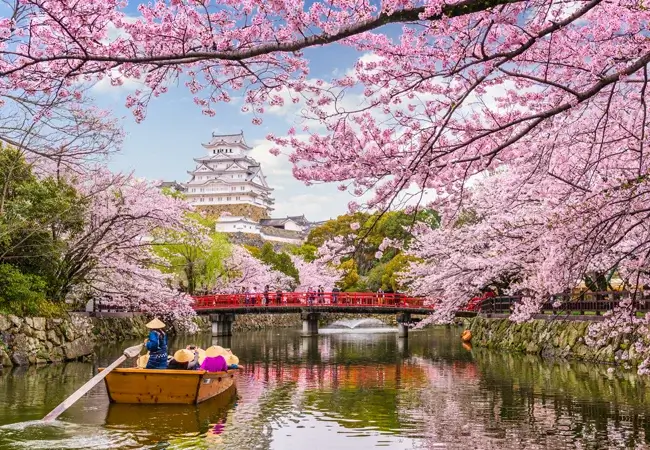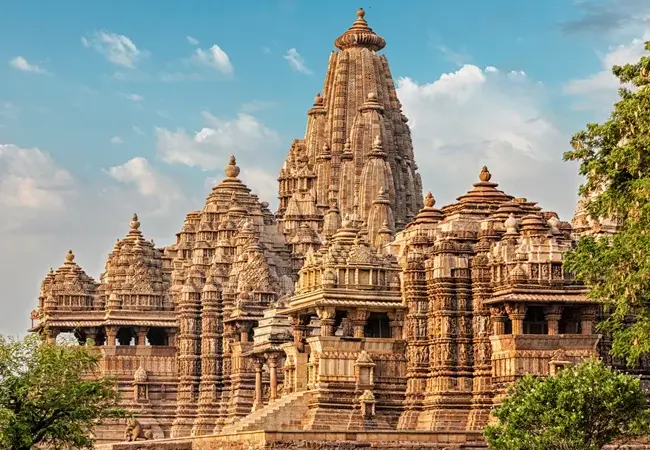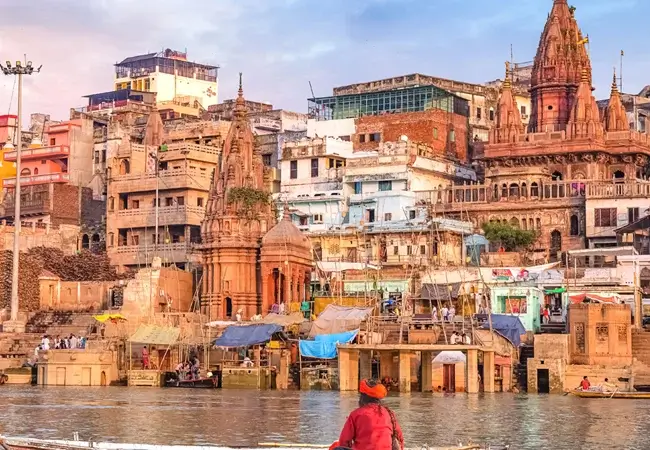
Varanasi
Varanasi, also known as Kashi and earlier called Banaras, is a holy city on the banks of the sacred Ganges River in northern India. It holds great importance in Indian culture as a center of pilgrimage, rituals, death, and mourning.
Recognized as one of the oldest living cities in the world, Varanasi is visited by devotees who believe that coming here brings spiritual peace and salvation. The city officially received the name Varanasi after 1947, while Kashi remains its ancient name.
Located about 692 km from New Delhi and 320 km from Lucknow, this spiritual destination attracts pilgrims from across India and abroad.
With our Varanasi religious travel packages, you can experience temple darshan, Ganga Aarti, and the holy ghats with comfort and guidance.
Varanasi, also called Kashi or Banaras, is among the world’s oldest continually inhabited cities. Its ancient name Kashi goes back over 2,500 years to the Kingdom of the same name. In the 8th century, Adi Shankaracharya established the worship of Lord Shiva here, making Varanasi a leading pilgrimage destination in India.
Apart from its religious importance, Varanasi is also famous for Kashi Vishwanath Temple, Ganga Aarti, and sacred ghats. The city is equally known for its silk weaving, carpets, and handicrafts, which employ thousands of locals and support the state’s economy, blending spiritual and cultural richness.

The Shree Kashi Vishwanath Temple is one of the most renowned and sacred temples in Varanasi, Uttar Pradesh, dedicated to Lord Shiva. Situated in the famous Vishwanath Gali, the temple stands on the western bank of the holy River Ganga. It is counted among the twelve Jyotirlingas of India, making it one of the most important shrines for devotees. The presiding deity, worshipped as Shri Vishwanath or Vishweshwara, translates to “Lord of the Universe.” Since the ancient name of Varanasi is Kashi, the temple is popularly known as Shree Kashi Vishwanath Temple.
Inside the temple, the revered Jyotirlinga of Lord Shiva has a unique and unmatched significance in India’s spiritual and religious history. Over centuries, it has drawn some of the greatest saints and philosophers, including Adi Shankaracharya, Ramakrishna Paramhansa, Swami Vivekananda, Goswami Tulsidas, Guru Nanak, Swami Dayananda Saraswati, Pramukh Swami Maharaj, Bamakhyapa, and many more. Their visits highlight the temple’s profound importance in India’s religious journey.
Pilgrims strongly believe that praying at the Kashi Vishwanath Temple, along with a sacred bath in the River Ganga, leads to Moksha (liberation). For this reason, people from across India and the world aspire to visit this temple at least once in their lifetime. Every year, millions of devotees include this temple in their Varanasi pilgrimage tours, making it the spiritual centerpiece of the city.

Varanasi, also known as Kashi, is one of the Sapt Puri—the seven holiest cities in India. Alongside Ayodhya, Mathura, Haridwar, Kanchipuram, Ujjain, and Dwarka, it holds immense spiritual significance. According to Hindu mythology, this sacred city was established by Lord Shiva himself, making it a must-visit destination for pilgrims and travelers seeking peace.
The holy River Ganga flows through Varanasi and is considered the purest river in Hindu beliefs. Devotees believe a dip in its waters washes away sins and brings spiritual liberation. Every evening, the city glows with the Ganga Aarti, a spectacular ritual performed by priests on the riverbanks. The most popular place to witness this is Dashashwamedh Ghat, located near the revered Kashi Vishwanath Temple. Other famous ghats include Assi Ghat and Rajendra Prasad Ghat.
The ceremony, performed with lamps, incense, and chants, creates a magical atmosphere. Watching the synchronized movements of priests against the backdrop of the river leaves visitors with a sense of peace and devotion. Though it involves fire, the ritual is performed safely and beautifully.
The aarti lasts around 45 minutes, beginning at 7 PM in summer and 6 PM in winter. At Safaar Travels, we enhance this spiritual journey with guided tours, evening boat rides, and curated pilgrimage packages, making your Varanasi trip truly unforgettable.

The Durga Temple, also called Durga Kund Temple, is among the most famous temples in Varanasi with deep religious significance in Hinduism. Dedicated to Goddess Durga, it was built in the 18th century under the patronage of Rani Bhabani of Natore. A sacred pond lies beside the temple, which was once connected to the holy River Ganga.
Equally important is the Tulsi Manas Mandir, where the great Hindu epic Ramcharitmanas was originally written by Goswami Tulsidas. The temple also houses a museum that preserves rare manuscripts and cultural artifacts.
With Safaar Travels, you can explore both temples through guided tours, ensuring a memorable and spiritual journey in Varanasi

The Birla Temple Varanasi, also known as the New Kashi Vishwanath Temple, is a stunning marble shrine constructed by the Birla Group of Industries. Dedicated to Lord Shiva, this sacred temple features one of the tallest temple towers in India and attracts thousands of pilgrims every year. Open daily from 4 AM to 12 PM and 1 PM to 9 PM, it is a must-visit on our Varanasi temple tour packages.

The Sankat Mochan Hanuman Temple Varanasi is one of the city’s most visited shrines, established in the 16th century by poet-saint Goswami Tulsidas. Dedicated to Lord Hanuman, it is located near Banaras Hindu University and draws countless devotees who recite Hanuman Chalisa and Sundarkand. The famous laddoo prasad offered here is loved by pilgrims. With Safaar Travels Varanasi temple tour packages, you can explore this sacred temple and experience its divine atmosphere.
Dashashwamedh Ghat, one of the oldest and most sacred ghats in Varanasi, is located near the Kashi Vishwanath Temple on the banks of the Ganga. According to legend, Lord Brahma performed the Dasa Ashwamedha Yajna here, giving the ghat its name.
The ghat is world-famous for the Ganga Aarti, held every evening with chanting, lamps, and rituals that attract thousands of devotees. During Kartik Purnima and Dev Deepawali, the ghat glows with countless diyas, creating a breathtaking sight.
Originally built in 1748 by Peshwa Balaji Baji Rao and later rebuilt in 1774 by Queen Ahilyabai Holkar, Dashashwamedh Ghat remains a spiritual and cultural hub of Varanasi

Manikarnika Ghat is one of the holiest cremation ghats in Varanasi, located on the banks of the sacred River Ganga. In Hindu belief, death here is not the end but a path to moksha (liberation), freeing the soul from the cycle of rebirth.
Countless devotees from across India wish to spend their final days near this ghat, as being cremated at Manikarnika is believed to grant eternal peace. Despite its association with death, the ghat reflects the spiritual essence of Varanasi, where life and liberation come together.

The construction of this temple marked an important chapter in the glorious history of the independence of India. It required six years to build this temple and was inaugurated by Mahatma Gandhi. This temple is dedicated to Mother India and is present inside the complex of Mahatma Gandhi Kashi Vidyapith, an esteemed university of Varanasi. This temple is unique from the rest of the temples of India as it doesn’t worship any Hindu deity. Rather, it worships the country of India.
Sarnath is also known by the names of Sarangnath, Isipatana, Rishipatana, Migadaya, or Mrigadeva. This place is located at a distance of 10 km to the northeast of Varanasi, near the confluence of the Ganges and the Varuna rivers. This city is popular because, in this region, Gautam Buddha taught his first sermon after attaining enlightenment at Bodh Gaya at the age of 35. Moreover, it is also where the Buddhist sangha first came into effect as a result of the enlightenment of his first five disciples. According to the Mahaparinibbana Sutta, the Buddha mentioned Sarnath as one of the four places of pilgrimage his followers need to visit and look upon with feelings of reverence.

Another popular ghat of Varanasi is the Assi Ghat which tourists tend to visit regularly. It occupies the southern part of the holy city of Varanasi at the confluence of the Ganges and Assi rivers. People arrive at Assi Ghat for a wide range of reasons. Some of them visit this ghat to soak in the spiritual atmosphere and attain some relaxation of mind, while some simply enjoy the famous evening aarti and get a glimpse into the local culture.
According to a mythological tale, Goddess Durga, after killing the demons Shumbha-Nishumbha, threw her sword and it landed in this region. It resulted in the emergence of a river which was then called Assi. The locals believe that taking a dip at Assi Ghat is equivalent to taking a dip at thousand of other holy rivers.

The best time to visit Varanasi is from November to March, when the weather is cool and pleasant. This period is ideal for exploring the ghats, attending the grand Ganga Aarti, and experiencing festivals like Dev Deepawali and Makar Sankranti. The winter season makes temple visits and boat rides on the Ganga more comfortable, offering the perfect spiritual and cultural experience of the holy city.













